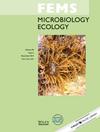解密暴露于灵芝的无症状油棕幼苗的根相关微生物群落:油棕耐病性的新见解。
IF 3.5
3区 生物学
Q2 MICROBIOLOGY
引用次数: 0
摘要
了解无症状油棕幼苗中的微生物群落对于开发抑制油棕基部茎腐病(BSR)的微生物群落至关重要。在这项研究中,我们比较了接种鲣节灵芝后对照组、无症状组和有症状组幼苗的土壤、根瘤层和内层的微生物群落。我们的研究结果表明,微生物结构和相互作用发生了重大变化,尤其是在无症状幼苗中。放线菌群(Actinobacteriota)和子囊菌群(Ascomycota)在这些样本中明显富集,其中放线菌群被确定为关键类群。长读数猎枪元基因组学表明,67.4%的富集放线菌群类群是无症状幼苗所独有的。同样,子囊菌目(Ascomycota)成员也显示出显著的富集,表明它们在抑制 BSR 中的潜在作用。在各种分析中这些门类的一致鉴定强调了它们在抗病中的重要性。这是第一份详细描述无症状幼苗和有症状幼苗中原核生物和真菌群落变化的报告,有助于深入了解油棕幼苗在大块土壤、根瘤层和内圈三个区系中潜在的病害抑制类群。本文章由计算机程序翻译,如有差异,请以英文原文为准。
Deciphering Root-associated Microbial Communities in Asymptomatic Oil Palm Seedlings Exposed to Ganoderma boninense: New Insight into Disease Tolerance of Oil Palms.
Understanding the microbial communities in asymptomatic oil palm seedlings is crucial for developing disease-suppressive microbiota against basal stem rot (BSR) in oil palm. In this study, we compared the microbial communities in bulk soil, rhizosphere, and endosphere of control, asymptomatic, and symptomatic seedlings following inoculation with Ganoderma boninense. Our findings revealed significant shifts in microbial structure and interactions, particularly in asymptomatic seedlings. Both Actinobacteriota and Ascomycota were notably enriched in these samples, with Actinobacteriota identified as keystone taxa. Long-read shotgun metagenomics demonstrated that 67.4% of enriched Actinobacteriota taxa were unique to asymptomatic seedlings. Similarly, Ascomycota members showed significant enrichment, suggesting their potential role in BSR suppression. The consistent identification of these phyla across various analyses underscores their importance in disease resistance. This is the first report detailing the shifts in prokaryotic and fungal communities in asymptomatic and symptomatic seedlings, offering insights into potential disease-suppressive taxa across three compartments: bulk soil, rhizosphere, and endosphere of oil palm seedlings.
求助全文
通过发布文献求助,成功后即可免费获取论文全文。
去求助
来源期刊

FEMS microbiology ecology
生物-微生物学
CiteScore
7.50
自引率
2.40%
发文量
132
审稿时长
3 months
期刊介绍:
FEMS Microbiology Ecology aims to ensure efficient publication of high-quality papers that are original and provide a significant contribution to the understanding of microbial ecology. The journal contains Research Articles and MiniReviews on fundamental aspects of the ecology of microorganisms in natural soil, aquatic and atmospheric habitats, including extreme environments, and in artificial or managed environments. Research papers on pure cultures and in the areas of plant pathology and medical, food or veterinary microbiology will be published where they provide valuable generic information on microbial ecology. Papers can deal with culturable and non-culturable forms of any type of microorganism: bacteria, archaea, filamentous fungi, yeasts, protozoa, cyanobacteria, algae or viruses. In addition, the journal will publish Perspectives, Current Opinion and Controversy Articles, Commentaries and Letters to the Editor on topical issues in microbial ecology.
- Application of ecological theory to microbial ecology
- Interactions and signalling between microorganisms and with plants and animals
- Interactions between microorganisms and their physicochemical enviornment
- Microbial aspects of biogeochemical cycles and processes
- Microbial community ecology
- Phylogenetic and functional diversity of microbial communities
- Evolutionary biology of microorganisms
 求助内容:
求助内容: 应助结果提醒方式:
应助结果提醒方式:


